Tarragon is a cold hardy perennial herb with a sweet anise-like flavor that’s a star in French cuisine and useful in a wide range of dishes.
The flavorful leaves are rich in essential oils, and make a delicious addition to eggs, poultry, seafood, tomatoes, and much more.
Tarragon is one of the first herbs to break winter dormancy, sending up shoots in late winter to early spring.
Cultivation and care is simple and easy making it an excellent choice for the beginning gardener or herbalist.
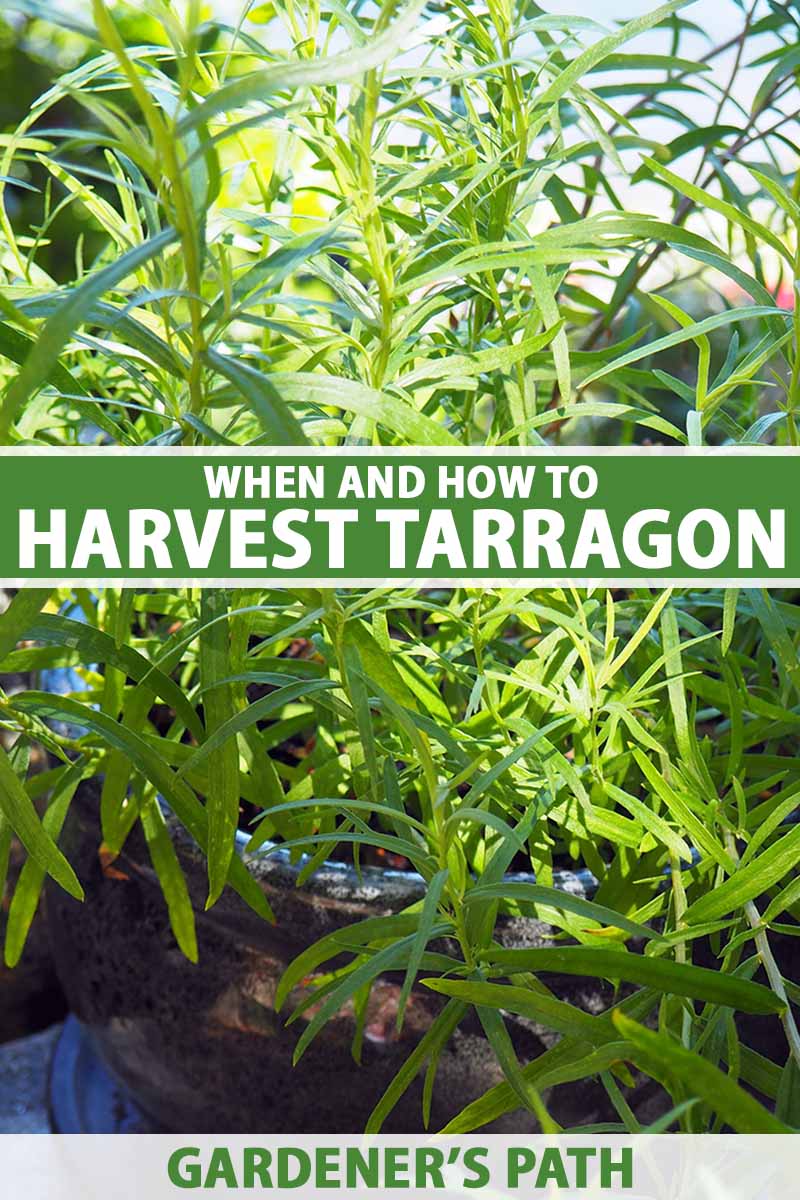
We link to vendors to help you find relevant products. If you buy from one of our links, we may earn a commission.
In our guide to growing tarragon, we cover how to cultivate this herb in your garden.
It thrives in containers, garden beds, or on a sunny windowsill for indoor growth.
And with a bit of selective trimming, you can enjoy a steady supply of leaves throughout spring and even through the hot months of summer.
So get out your snips and learn how to enjoy a continuous harvest of tarragon!
Here’s what’s covered:
How to Harvest Tarragon
For the heavy tarragon user (that’s me!), growing a selection of three or four plants in garden beds or containers can provide a steady supply of tasty leaves from March through September.
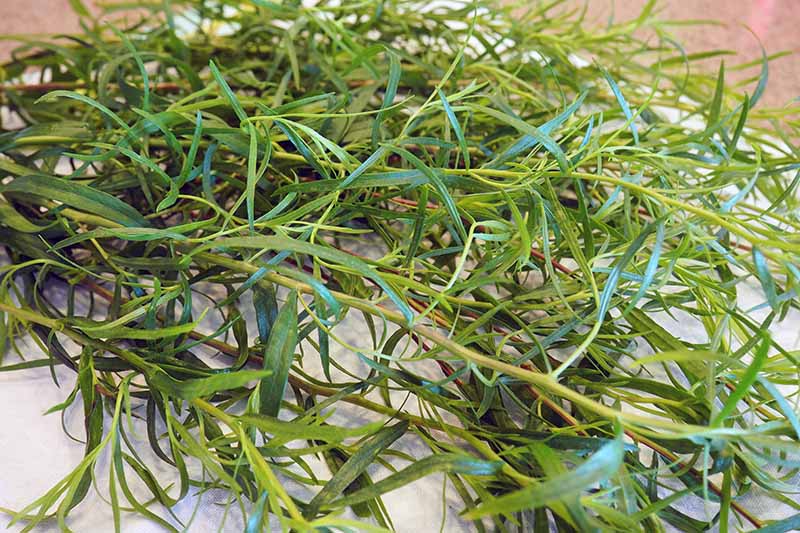
These fast-growing plants are most productive when cut regularly to encourage branching, and regrowth is rapid – the cut stems are ready for harvesting again in about four to six weeks.
When to Pick for Peak Flavor
For optimal flavor, herbs should be harvested when their essential oils are at their peak.
This is typically in the morning, after the dew has dried and before the leaves are exposed to the sun. Once the heat of the sun hits the plant, essential oils are released into the air and flavor diminishes.
Start Early
As a rule of thumb, tender herbs can be harvested when they have enough leaves to maintain healthy growth.

And because tarragon is one of the first herbs to appear after winter, the harvest can start in early spring by pinching out the growing tips.
To pinch new tops, wait until the stems are at least four to five inches tall before pinching cleanly between the leaves, taking only the top one third of leafy growth.
Continue to pinch out tender tips throughout early spring as needed. This early top growth is very green and delicate and easily pinched by hand.
But as plants grow, the stems become fibrous and pinching at this stage produces mangled, broken stems and bruised leaves.
As plants mature, you can cut back taller, fibrous stems to about five or six inches using a sharp, sterile knife or garden scissors.
A Midseason Shear
Tarragon likes it cool and grows most prolifically in spring.
By summertime, growth can slow and plants benefit from a rejuvenating trim that delivers continuous leaf production through the hot months of July, August, and September.
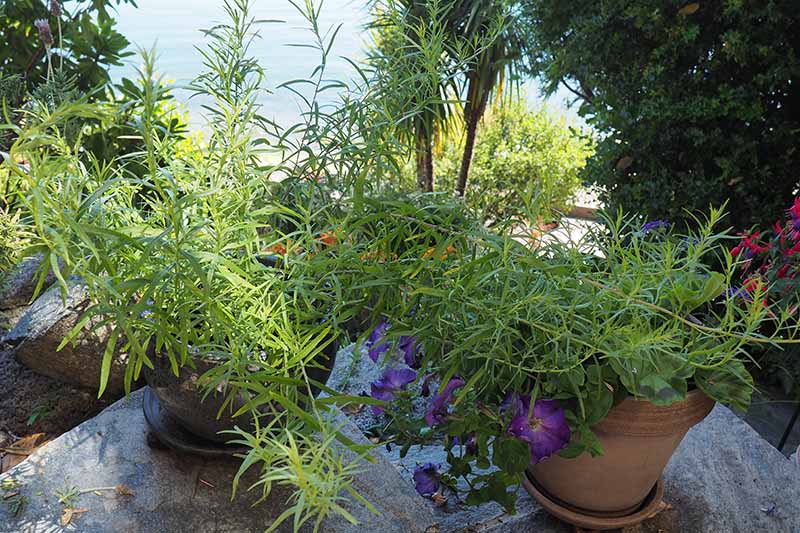
But regrowth takes four to six weeks before it’s ready to harvest again, and you don’t want to go that long without fresh herbs if you don’t need to. And you don’t!
The key is to shear back only one-half of your plants at a time. As you’re waiting for the new growth to appear, you can harvest the remaining stems as needed.
To shear, simply cut the stems back cleanly to five or six inches using a sharp, sterile knife or scissors.
If you have a single plant or container, select the tallest stems to shear first. Continue to harvest by cutting the remaining stems as needed, which nicely staggers the stages of regrowth.
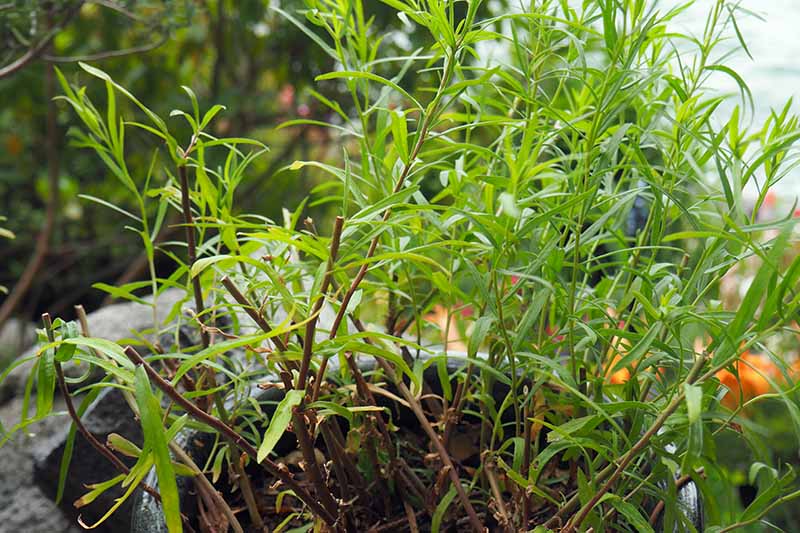
If you have multiple plants or containers, shear back individual plants or pots at four week intervals to ensure there’s always a steady supply of fresh leaves available.
After the midseason shear, you may have a surplus of fresh leaves – check out the suggestions on what to do with them in the Preserve the Surplus section below.
The Final Cut
At the end of the growing season, harvest all stems by shearing the whole plant to four inches.
The timing of the final cut should be about one month before your expected first frost date, or around mid-September.
Shearing late in the season as cool weather approaches helps to prevent new growth, which can be killed by an early frost and lead to plant damage.
This late harvest also helps to prepare plants for a safe winter dormancy.
How to Store the Surplus
When you have an excess of sprigs, try one of these methods to preserve your tarragon.
Fresh
Fresh stems, stripped of their lowest leaves, can be kept in the fridge for up to two weeks in a small glass of water.
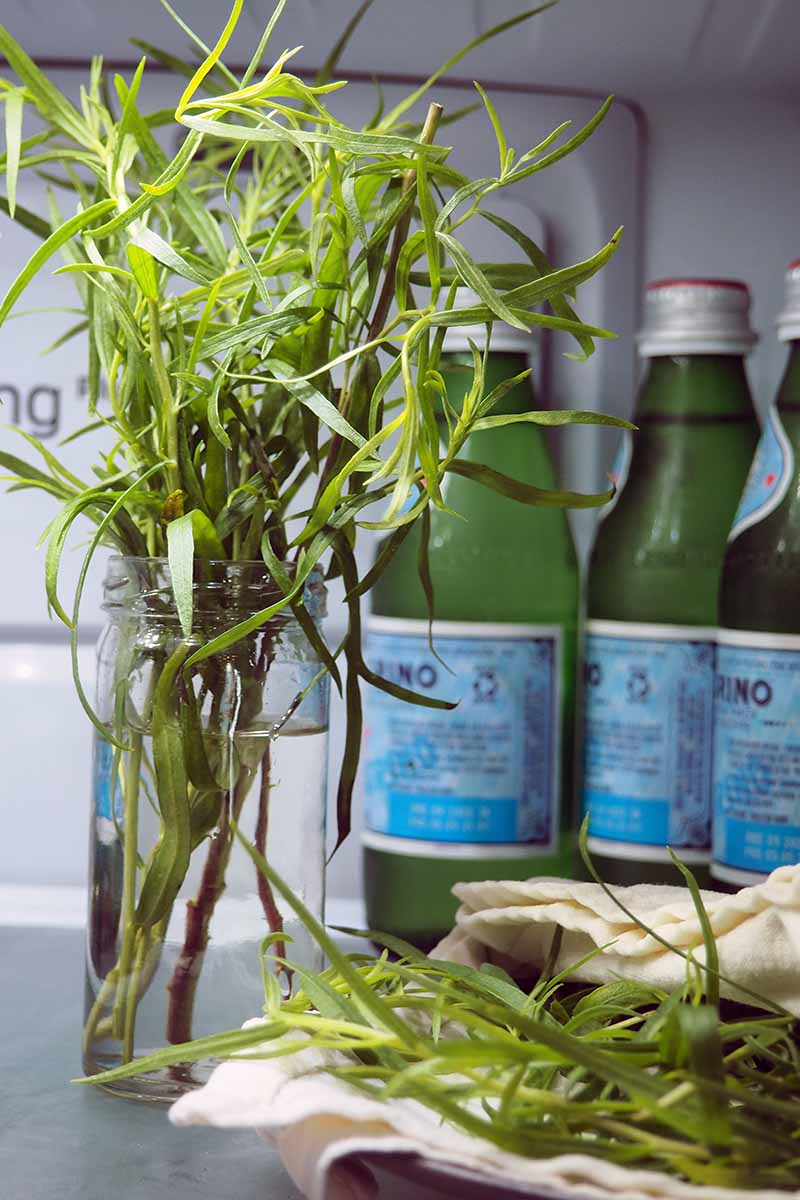
Or you can layer stems in a damp cloth or paper towel and place them in a plastic bag or storage container in the fridge.
Drying
Tarragon can be dried, but the essential oils dissipate quickly and flavor can be elusive. For best flavor, use dried leaves within four weeks.
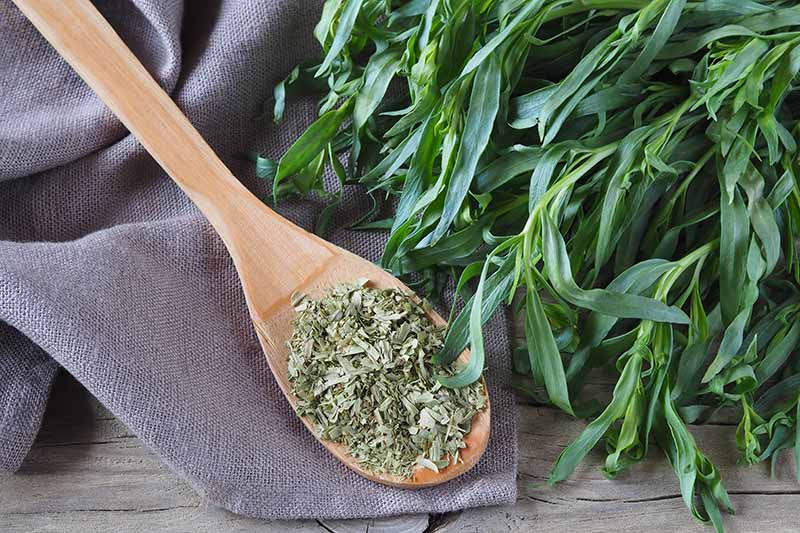
To dehydrate your harvest, bundle cut stems loosely with garden string and hang in a dark, dry, and warm environment until they are dry, which usually takes between two to six weeks.
When they are completely dry, strip the leaves from the stems and crumble lightly.
Store in glass containers with a tight fitting lid in a cool, dark cupboard.
Herbs like tarragon can also be dried in a food dehydrator set to the lowest temperature.
Read our full guide to drying garden herbs for more tips.
Freezing
Freezing offers better flavor retention. And although the leaves darken, they can be used to add flavor to many cooked dishes like sauces, soups, and stews.

To freeze, use your fingers to strip leaves from stems then mince coarsely. Fill ice cube trays to two thirds with minced leaves and top with water or olive oil before placing in the freezer.
When they are frozen solid, remove the cubes from trays and store in the freezer in airtight containers for up to six months.
Alternatively, you can freeze six- to eight-inch sections of stems – with leaves still attached – on a cookie tray for three or four hours.
When frozen, store in airtight containers in the freezer.
You can learn more about how to freeze herbs in our guide.
In Vinegar
Preserving the flavor of tarragon in vinegar is another popular option.

Place one cup of tarragon sprigs in a clean, sterile jar and top with two cups of your favorite vinegar.
To release essential oils and flavor, use the handle of a wooden spoon to bruise the leaves gently in the jar.
Cover and store in a cool, dark cupboard for two to three weeks. Strain into a sterile, ornamental jar and add fresh sprigs if desired.
Seal the jar and store in a cool, dark cupboard for up to six months.
Nonstop Flavor
The tarragon harvest starts early and finishes late. And with just a little judicious pruning, you can enjoy nonstop flavor from spring to fall!
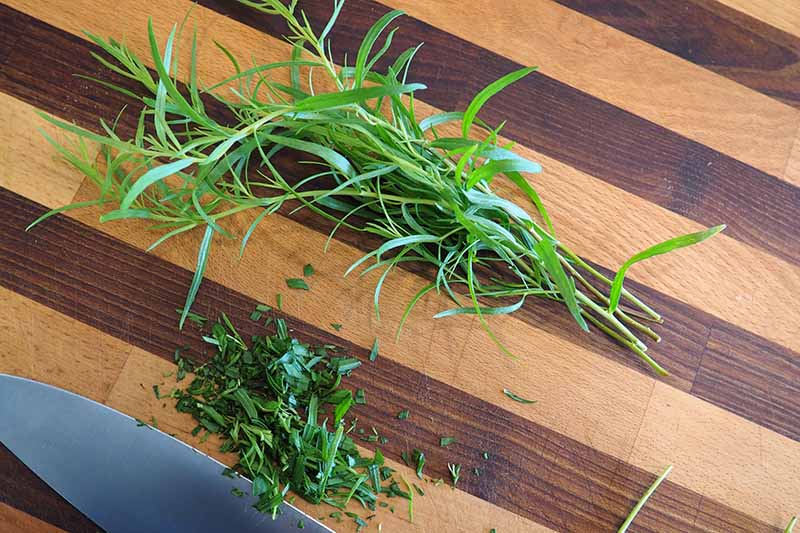
Start by pinching out the tender tips of new growth shortly after they send up shoots. Then rejuvenate plants with a half-shear at the start of summer and wrap the season up with a complete shear as autumn nears.
You’ll love how quickly plants respond to a trim and you can relish their sweet flavor for the entire growing season – and beyond!
How do you folks use your tarragon harvest? Let us know in the comments section below.
And for more herbal know-how, check out these guides next:

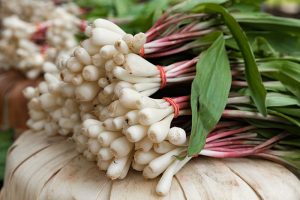

I have a tarragon plant and harvest and dry when in full growth. Lately there is a whole new growth emerging from the plant with lighter green and less aromatic leaves which are slightly larger than the host leaves – are they still tarragon?
Hi Barbara, is this an indoor plant? Indoor lighting could account for the milder taste and aroma. Or are you in an area with mild winters? Tarragon typically dies back in winter, but if you’re in a region with warm temperatures, it could be early growth. And I think that weak winter sunshine could also be responsible for the mild flavor and aroma… Also, I find that the early season leaves when temperatures are still cool, are usually larger than those produced in summer. Can you attach a photo? My guess is, if they’re growing from your plant and have… Read more »
Where can I buy a tarragon plant in or near west palm beach Florida
Hey Nikki, if you type something like “west palm beach florida garden centers” into your browser, oodles of garden centers are listed and no doubt some will carry herbs.
However, you might want to consider planting Mexican tarragon for your area – it handles heat and humiditiy better than A. dracunculus.
I have to admit that I am a tarragon/bearnnaise sauce junkie. This is my first attempt at growing this amazing herb. I now make my own bearnnaise sauce which is so much better than jars/sachets from Supermarkets. My latest creation is to buy an oil based tinned tuna & adding a desired amount of either fresh, dried or frozen tarragon overnight in an airtight container in the fridge. Drain off the oil before using in your desired dish…Amazing!!! I also add to sautéed mushrooms (in butter with black pepper, garlic purée & a good dollop of English or Dijon mustard)… Read more »
Thanks for your ideas Jacqui, it has amazing flavor!